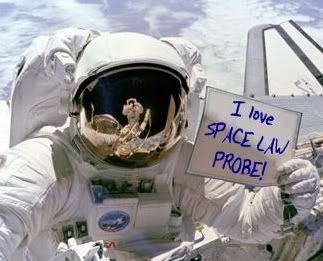9.07.2005
Orbiting Witnesses
You don't have to be a space lawyer to equate satellites with good law practice. Smart litigators and prosecutors obtain images from remote sensing satellites for use as evidence in pending cases.
It's not exactly a new idea. Missy Frederick at Space.com has a recent interesting example: Lawyers for the state of Arizona got their hands on images from Space Imaging's Ikonos satellite for a case against a developer accused of illegally clearing hundreds of acres of state trust lands and thousands of acres of private lands along with portions of several Native American archeological sites. Was the land bulldozed clear as Arizona claims? Ikonos doesn't lie.
And Space Imaging doesn't mind bragging about its satellite's starring role in the case, either. After all, orbiting 423 miles high, the satellite can see objects on earth as small as one meter.
As Professor Joanne Gabrynowicz, director of the National Remote Sensing and Space Law Center told Space.com, the strategy of using satellite images is "very successful because it's very persuasive evidence." She pointed out that some attorneys settle out of court rather than face a trial when they are up against satellite images. Professor Gabrynowicz even recalls that the L.A.P.D. contacted her to ask if there was any imagery that could help it in the O.J. Simpson murder trial. "There wasn't, but it's important they're sophisticated enough to know it exists and to ask the question."
As we've seen, other users of satellite images include government agencies looking into insurance fraud by farmers, farm-program compliance and environmental law violations. (See, Who's watching your farm?)
Meanwhile, the technology advances and satellite imagery grows cheaper and more widely available. Future law in this arena will focus on the obvious big brother concerns and related issues associated with shooting high-tech pictures from orbiting cameras. More litigation, naturally, will follow.
It's not exactly a new idea. Missy Frederick at Space.com has a recent interesting example: Lawyers for the state of Arizona got their hands on images from Space Imaging's Ikonos satellite for a case against a developer accused of illegally clearing hundreds of acres of state trust lands and thousands of acres of private lands along with portions of several Native American archeological sites. Was the land bulldozed clear as Arizona claims? Ikonos doesn't lie.
And Space Imaging doesn't mind bragging about its satellite's starring role in the case, either. After all, orbiting 423 miles high, the satellite can see objects on earth as small as one meter.
As Professor Joanne Gabrynowicz, director of the National Remote Sensing and Space Law Center told Space.com, the strategy of using satellite images is "very successful because it's very persuasive evidence." She pointed out that some attorneys settle out of court rather than face a trial when they are up against satellite images. Professor Gabrynowicz even recalls that the L.A.P.D. contacted her to ask if there was any imagery that could help it in the O.J. Simpson murder trial. "There wasn't, but it's important they're sophisticated enough to know it exists and to ask the question."
As we've seen, other users of satellite images include government agencies looking into insurance fraud by farmers, farm-program compliance and environmental law violations. (See, Who's watching your farm?)
Meanwhile, the technology advances and satellite imagery grows cheaper and more widely available. Future law in this arena will focus on the obvious big brother concerns and related issues associated with shooting high-tech pictures from orbiting cameras. More litigation, naturally, will follow.






